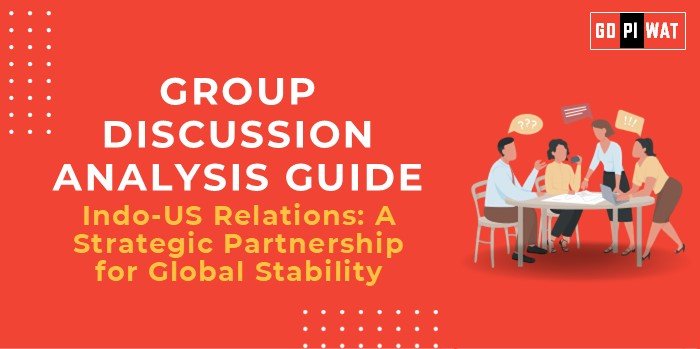📋 Group Discussion (GD) Analysis Guide
🌍 Indo-US Relations: A Strategic Partnership for Global Stability
🌟 Introduction
Indo-US relations are a cornerstone of global geopolitics, driven by shared democratic values and strategic interests. As the world grapples with shifting power dynamics, this partnership has become essential in addressing challenges in trade, security, and technology, particularly in the Indo-Pacific region.
📊 Quick Facts & Key Statistics
- 💼 Trade Volume: $131 billion in bilateral trade (FY 2022-2023) – The U.S. is India’s largest trading partner.
- 🛡️ Defense Deals: $25 billion+ in contracts since 2007, including a $3.3 billion agreement for MQ-9B Predator drones.
- 👥 Indian Diaspora in the U.S.: ~4.8 million – A significant contributor to sectors like technology and medicine.
- 🤝 Quad Alliance: A strategic partnership addressing Indo-Pacific security and economic cooperation.
🤝 Stakeholders and Their Roles
- 🏛️ Governments: Collaborate on defense, trade, and climate initiatives.
- 💻 Private Sector: Companies like Boeing, Google, and Infosys drive innovation and investment.
- 👥 Indian Diaspora: Strengthen economic and cultural ties.
- 🌍 Quad Members: Enhance regional stability and counterbalance rising geopolitical threats.
📈 Achievements and Challenges
🏆 Achievements:
- ✔️ Economic Ties: $131 billion trade volume reflects growing economic interdependence.
- 🛡️ Defense Cooperation: Landmark deals like MQ-9B drones and foundational agreements like LEMOA.
- 🤖 Technology & Innovation: Joint ventures in AI, semiconductors, and green energy.
- 🤝 Strategic Alliances: The Quad fosters regional security and economic development.
⚠️ Challenges:
- 📉 Trade Barriers: Tariffs and disputes over intellectual property rights.
- 🌏 Geopolitical Tensions: Balancing relationships with Russia and addressing China’s influence.
- 🛂 Immigration Issues: H-1B visa uncertainties affect workforce mobility.
🗣️ Effective Discussion Approaches
💬 Opening Approaches:
- 📊 Highlight the economic impact with the $131 billion trade figure.
- 🌏 Discuss the Quad’s strategic role in the Indo-Pacific.
- 🛡️ Use a case study like the MQ-9B drone deal to showcase defense collaboration.
🤔 Counter-Argument Handling:
- 💡 Acknowledge trade tensions while emphasizing ongoing negotiations.
- 📢 Balance geopolitical concerns with examples of progress, like Quad summits.
📌 Strategic Analysis of Strengths & Weaknesses
✅ Strengths:
- ✔️ Robust trade and defense partnerships.
- 🌍 Shared democratic values.
- 💻 Technological collaboration.
❌ Weaknesses:
- 📉 Persistent trade disputes.
- ⚠️ Dependence on the U.S. for technology and arms.
🌟 Opportunities:
- 🌱 Expanding renewable energy partnerships.
- 🤖 Collaborating on AI and cybersecurity.
⚠️ Threats:
- 🌏 Rising Chinese influence.
- 🚫 Protectionist policies in trade.
📚 Structured Arguments for Discussion
- 🟢 Supporting Stance: “The Indo-US partnership is a pillar of global stability, promoting security and economic growth in the Indo-Pacific.”
- 🔴 Opposing Stance: “Trade disputes and geopolitical challenges hinder the full potential of Indo-US relations.”
- ⚖️ Balanced Perspective: “While strong in defense and trade, Indo-US ties require greater efforts to resolve disputes and ensure mutual growth.”
🎓 Connecting with B-School Applications
📖 Real-World Applications:
- 🌍 Study of global supply chain management in Indo-US trade.
- 🤝 Analysis of strategic alliances like the Quad in business and geopolitics.
❓ Sample Interview Questions:
- 💬 “What role does the Quad play in shaping Indo-US relations?”
- 🛡️ “How do defense and technology partnerships influence trade?”
💡 Insights for B-School Students:
- 📘 Examine case studies on the Quad for strategy courses.
- 📊 Analyze U.S. trade policies in global economics projects.


